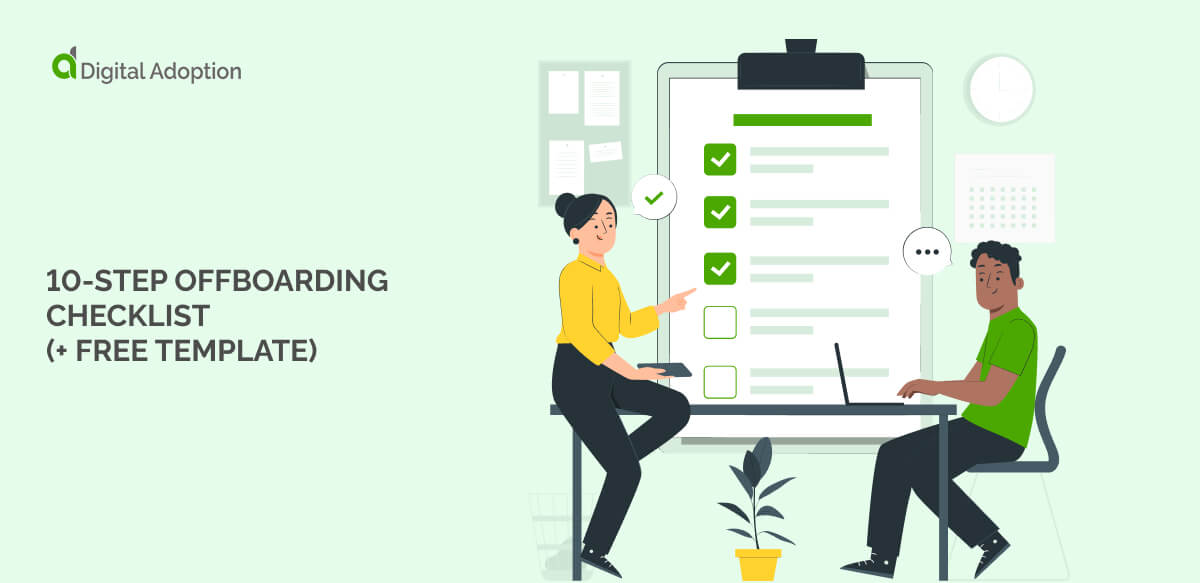The offboarding checklist demonstrates to departing staff that a competent company has valued them throughout their entire employment journey, from day one to their last, and that they are always welcome to return.
These checklists are essential when it costs USD 4,000 to 20,000 to hire new staff, and offboarding is considered as essential as user onboarding.
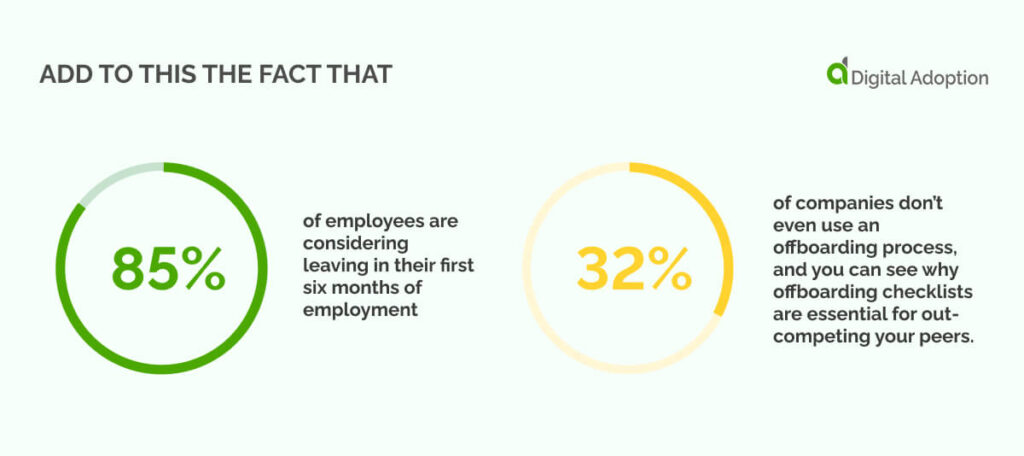
Add to this the fact that 85% of employees are considering leaving in their first six months of employment and that 32% of companies don’t even use an offboarding process, and you can see why offboarding checklists are essential for out-competing your peers.
See the employee offboarding process as a golden handshake given at the end of an employment period to thank a leaving team member for their service, much like a similar offering at the start of effective employee onboarding.
Offboarding also incentivizes the positive experience as a reason for them to return in the future and for existing employees to remain as they enjoy a positive employee experience.
To help you understand the ten-step offboarding checklist along with the free template, we will explore the following topics:
- What is offboarding?
- The importance of an offboarding checklist
- What to include in an offboarding checklist
- How to create a positive offboarding experience
- The cost of bad offboarding
What is Offboarding?
Offboarding marks the phase when an employee separates from the organization they served. It commences when an employee submits their resignation and concludes on their departure day. However, its impact lingers well beyond the employee’s exit.
Offboarding aims to facilitate a smooth transition for all parties, resolve outstanding matters, and guarantee the employee departs with a favorable impression of the company.
It also shows current employees that their organization cares about people even when they depart the company.
Why is an Offboarding Checklist Important?
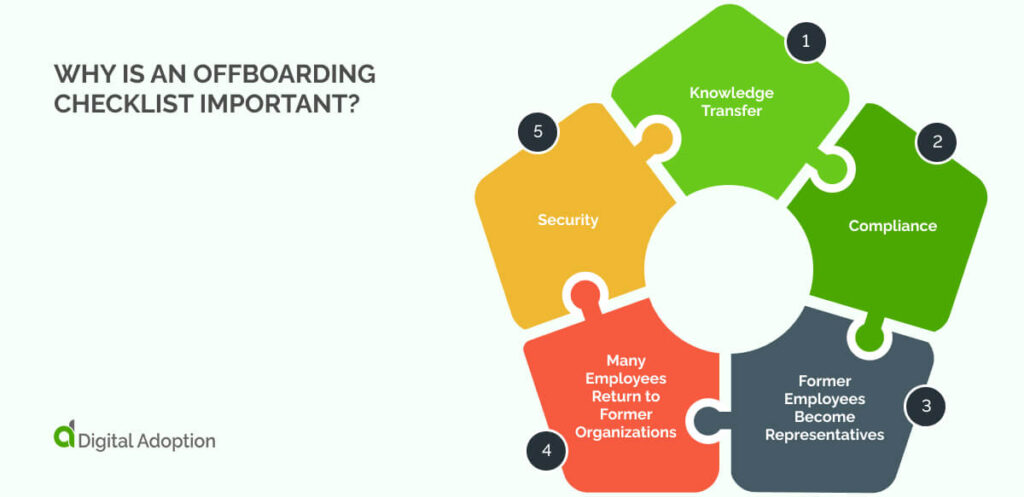
Let’s explore why employee offboarding is essential and justifies your attention and resources as part of an employee digital transformation.
Knowledge Transfer
Offboarding extends beyond impressions—it’s vital for knowledge transfer. Retaining departing employees’ expertise ensures smooth transitions and sustained productivity.
Compliance
Compliance is crucial based on industry and location. A well-defined offboarding process ensures adherence to regulations, preventing legal complications.
Former Employees Become Representatives
Former employees serve as representatives, shaping lasting impressions.
Critical “moments that matter” include the first day, team events, paychecks, promotions, and the offboarding process.
Positive memories can influence the company’s brand and appeal to new candidates.
Many Employees Return to Former Organizations
Former employees might return, with 47% considering rejoining. A positive offboarding experience contributes to this and benefits the organization by being cost-effective and ensuring cultural fit.
Former employees and customers highlight the importance of a positive offboarding process for maintaining loyalty.
Security
Many ex-employees retain access to former software applications or hardware, posing a threat. A thorough offboarding process mitigates this risk by revoking access promptly.
If you do not yet have an offboarding process in place and are unsure where to start, consider adapting your digital employee onboarding process, as offboarding is essential for the reasons in the list above.
Comprehensive 10-Step Offboarding Checklist
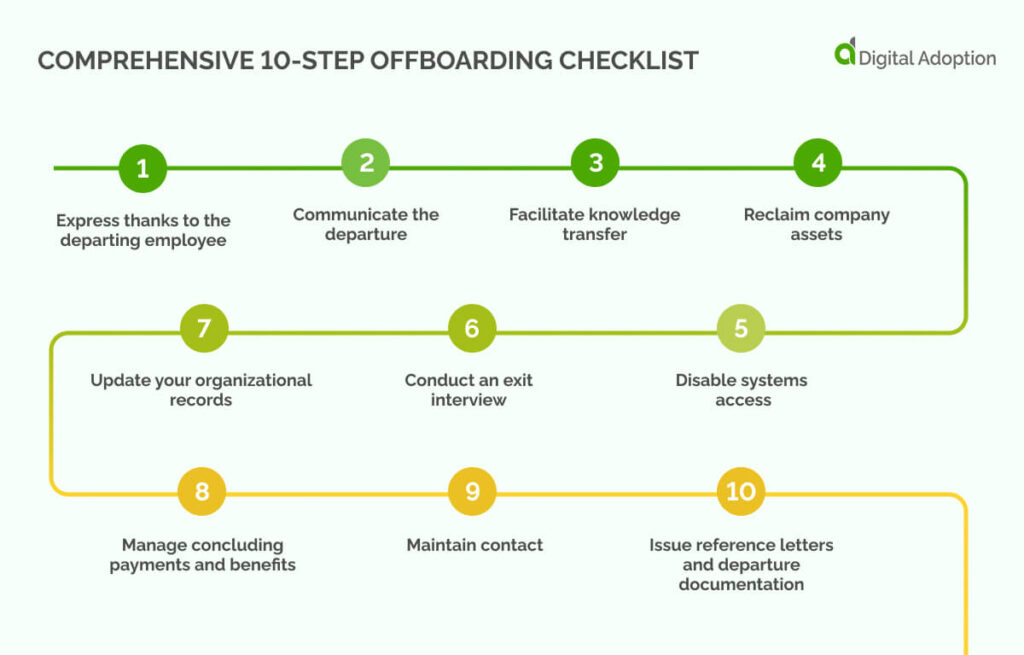
Follow these ten steps to your streamlined employee offboarding checklist experience.
You can also check out our handy employee offboarding checklist template to tick off each step covered above and ensure you complete every part of the process.
1. Express thanks to the departing employee
Express gratitude to the departing employee for their contributions and dedication throughout their tenure at the organization.
Ensure the leaving employee feels supported in their transition. Provide information about any available resources or assistance the organization can offer, whether it’s guidance on job searches, networking opportunities, or recommendations.
Emphasize the open-door policy, encouraging them to reach out if they need advice or support in the future.
Above all, ensure this interaction is genuine. It may be the least formal and vital opportunity to make a warm connection that will stay with the employee and may result in them returning if they feel genuinely valued on departure.
2. Communicate the departure
Avoid delays in informing the team about the employee’s departure to prevent rumors or gossip from disrupting the workplace.
Inform everyone about the employee’s exit, express gratitude for their service, and, if appropriate, provide details about the reasons behind their departure and the individual taking over their responsibilities.
Make sure to inform the employee’s direct team, managers, subordinates, payroll, and IT, as they will play a role in various offboarding processes. In customer-facing roles, consider communicating the departure to customers.
For senior managers, transparency may necessitate a public announcement regarding the employee’s departure.
3. Facilitate knowledge transfer
Whether you bring in a successor or not, preserving the departing employee’s knowledge within your company is crucial.
Ensure you have:
- A comprehensive overview of their daily tasks
- Clarity on task priorities
- Access rights to all systems and files they utilize
- A list of individuals they collaborate with, both within and outside the organization
Encourage the creation of a handover document or video containing valuable insights for the person stepping into their role. If the successor is ready to begin, initiate the handover promptly.
A positive offboarding process offers an additional benefit—if you need specific knowledge post-departure, the departing employee will gladly assist if they have had a positive offboarding experience.
4. Reclaim company assets
Request the departing employee to return company equipment on their final day, including company badges or lanyards, credit cards, uniforms, phones, laptops, or a company car.
Developing a comprehensive checklist of all assets is advisable to ensure you overlook nothing during retrieval.
5. Disable systems access
Thoroughly review your company’s tech stack and restrict the departing employee’s access to each tool, which includes:
- CRM tools
- Social media accounts
- Email platforms
- Intranet solutions
- Content databases
- Sales dashboards
Redirect emails from the departing employee’s account to avoid missing crucial client communications.
Update the organization’s records after their departure, and once you have filled the role, incorporate the new hire’s details for seamless internal communication.
Additionally, ensure all company materials featuring the departing individual’s information, such as the website and sales brochures, are promptly updated.
6. Conduct an exit interview
When executed effectively, a departure discussion can give you many insights, shedding light on your organization’s strengths and weaknesses and suggesting how to enhance the latter.
An exit interview typically involves a confidential meeting between the leaving team member of the HR team and the departing employee.
Take all employee feedback seriously, recognizing that this conversation significantly shapes how the departing employee perceives you as an employer to existing and future employees.
It is also essential to record all feedback without questioning it, as all experiences of employee frustration are valid and can help you improve your organization to improve retention.
Consider incorporating the following potential questions into the departure discussion:
- What influenced your decision to leave?
- How could we enhance the work experience here?
- Is there anything we could have done differently to retain you?
- What qualities should we prioritize in your successor?
- What aspects are we neglecting that could contribute to a more positive organizational culture?
- Would you recommend our company to job seekers in your network?
7. Update your organizational records
Ensure you update the organizational charts and directories upon an employee’s departure.
If there’s a designated successor, incorporate their details; if not, provide information about the individual taking on the role. Apply the same adjustments to brochures and the company website to prevent potential (internal) confusion.
8. Manage concluding payments and benefits
Like overlooking the revocation of a departing employee’s system access, companies may neglect to remove them from the payroll.
While many payroll systems include this feature, ensure the completion of the final payment process by coordinating with your payroll or finance department.
To facilitate a smooth process, provide them with comprehensive details, such as the employee’s end date, notice period, potential holiday payouts, and other pertinent information.
9. Maintain contact
There are various ways to stay in touch with former employees, such as via a talent pool or an alumni group. Both options allow you to send former employees the latest company news (and vacancies) so that they remain in the loop if they want to be.
Dedicated corporate alumni software providers like Aluminati and EnterpriseAlumni can be great.
But staying in touch has other benefits, too. As we briefly mentioned, it can be helpful if you’ve lost some knowledge only the leaving employee had or if their successor needs help with a specific task.
From the former employee’s perspective, staying in touch has advantages too, for example, when they need a reference or a letter of recommendation, or if one day they see a vacancy that piques their interest and potentially wants to return.
10. Issue reference letters and departure documentation
Your departing employee might seek a reference letter or, at the very least, a service certificate as proof of employment.
The extent of documentation provided will vary based on the circumstances of their departure. However, legal obligations necessitate the provision of final pay details, a service certificate, and requested contracts, so ensure you are ready for these requirements.
Follow these steps to make your departing staff feel valued and encourage them to return if they choose. You can also use our employee offboarding checklist template to help you complete every part of the process.
How do you create a positive offboarding experience?
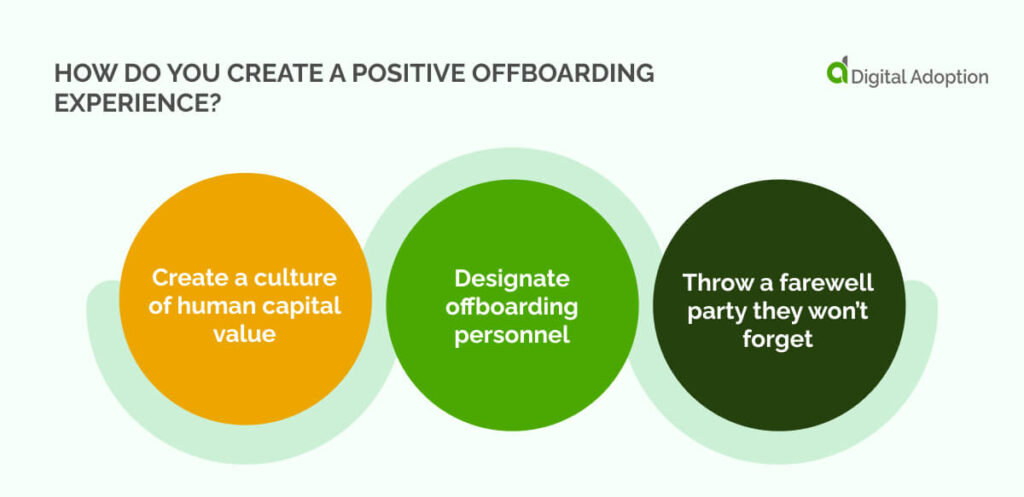
When offboarding employees, consider these commonly recommended practices.
Create a culture of human capital value
Ensure that leaders at every level interact and behave in a way that makes all employees feel valued so they will be likely to return when a staff leaves.
Designate offboarding personnel
Appoint someone responsible for overseeing the offboarding process to guarantee its smooth execution. Show all employees that you treat them as well when they leave and join your company.
This specialized staff can also consult on strategies to ensure the company nurtures a culture of human capital value.
Throw a farewell party they won’t forget
Express gratitude for their contributions with a group card or a team lunch to create a positive departure experience.
Following these practices will contribute to your departing team member leaving with positive sentiments, acknowledging the growth achieved during their journey with the organization.
For added convenience, utilize an employee offboarding checklist template to streamline the process and ensure comprehensive coverage.
How much does bad offboarding cost?
Not following best practices and following the employee offboarding process to ensure you complete every step can be costly. These experiences can cost organizations up to $7,687 per year.
The top five most costly experiences of poor offboarding practices, shown in the percentages companies experience them, are:
- The backend of the company’s website was hacked (32%)
- Loss of office supplies (30%)
- Loss of company data (29%)
- Loss of shared files (28%)
- Data breach (28%).
The high costs of poor offboarding are one of the main reasons it is essential to implement a robust checklist.
Make offboarding part of your culture today
Incorporate thoughtful offboarding practices into your organizational culture to leave a lasting positive impression on departing team members.
Consistently update checklists, foster ongoing connections, designate responsible personnel, and ensure meticulous final arrangements.
Doing so not only upholds professionalism but also nurtures a workplace culture that values and respects every employee’s journey, contributing to long-term organizational success.
Encourage the leadership team and human resources department to embrace these practices to make offboarding an integral part of your company culture to increase retention and reduce departures as part of your future of work strategy to promote employee experience and retention.

